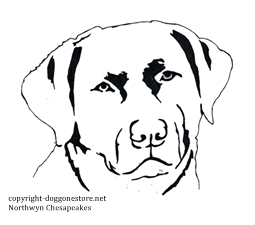|
Entropion
Authored by: Becky Lundgren, DVM
Entropion
is an uncomfortable or painful condition in which the animal’s eyelids
roll inward, allowing the eyelashes (or other hair) to rub against the
cornea and irritate it. The upper and/or lower eyelids can be involved,
and the condition can occur in either one eye or both.
Signs
An animal with entropion will squint and have an excessive amount of
tears coming from the affected eye. Some animals will be sensitive to
light and will rub at their eyes, particularly when they’re outside.
Some animals will produce a mucous-like discharge from the eyes.
Flat-faced dog/cat breeds, with entropion that involves the inside
corner of the eyes, may not show any discomfort -- simply because of
their facial structure.
In
some animals, entropion is never more than a minor annoyance, but in
others it can cause painful ulcers and erosions that cause scarring and
affect vision. That level of entropion needs surgical correction.
Causes
While any dog can have entropion, there is often a genetic factor. When
caused by genetics, entropion can be seen well before a dog’s first
birthday. Predisposed dog breeds include the Boxer, Bull Mastiff,
Cavalier King Charles Spaniel, Chesapeake Bay Retriever, Chow Chow,
Cocker Spaniel, English bulldog, Golden Retriever, Great Dane, Irish
Setter, Irish Setter, Labrador Retriever, Poodle, Pug, Shar Pei,
Springer Spaniel, and St. Bernard. Selective breeding for specific
traits (e.g., skull formation, skin folds on the face, and prominent
eyes) are thought to be contributing factors to genetic causes, but are
most likely not the only genetic base. Selective breeding may have
simply exaggerated entropion in breeds that were already prone to it.
Entropion
can also occur as a secondary condition resulting from scarring of the
eyelid, infection, corneal spasms and pain, trauma, or nerve damage.
Sometimes it happens after the eyelids lose their normal neurologic
function.
Diagnosis
Your veterinarian can diagnosis entropion through an ocular exam. A
local anesthetic is usually used, to make the examination easier on the
animal.
Because
it’s important to determine whether or not there is a corneal ulcer
secondary to the entropion, a fluorescein dye may also be used. The
fluorescein will stick to damaged parts of the cornea, and show as a
bright green area.
Treatment
Medical treatment with antibiotic ointments can decrease damage to the
cornea, but it can not resolve the entropion itself. To fix the eyelid,
surgery is needed.
Basic Do's and Dont's
If
the entropion is significant enough to warrant treatment, the excess
skin of the outer lids can be removed in a simple surgery called
blepharoplasty. (Essentially, this is plastic surgery, so you can tell
everyone your pet is having “his lids done”). Excess skin that
causes skin folds is also removed, and the eyelids are tightened.
Typically the entropion does not return after surgery, unless the case
is quite severe.
(Recurrence
is more common in Shar Peis, due to the breed’s excessive facial skin
folds.) The sutures should be removed in about 10 to 14 days. Some dogs
will need to wear an Elizabethan collar to prevent them from rubbing at
their sutures.
Young puppies generally only have a minor procedure called lid tacking,
rather than the full blepharoplasty. Permanent surgery like the
blepharoplasty isn’t typically done in puppies who are less than 6
months old, because it’s not possible to predict what the (adult) head
conformation will be, and the full surgery may not be needed. In lid
tacking, temporary sutures are used to roll out the eyelids, and keep
the puppies’ eyes healthy until these puppies mature and grow into
their adult facial features. Entropion can be seen in Shar Peis as young
as two or three weeks old, and these Shar Pei puppies do very well with
the temporary eyelid tacking.
If
the animal has corneal ulcers, those will need to be treated too.
Untreated corneal ulcers may scar excessively, impairing vision.
Treatment will reduce the incidence of scarring. Treatment usually
involves the use of antibiotic ophthalmic ointment. (To administer
ophthalmic ointment, place your thumb directly below the eyelid and very
gently push, which will cause the lower eyelid to pull away from the
eye. Put the ointment in the opened lower lid.)
The
sutures should be removed in about 10 to 14 days. Some dogs need to wear
an Elizabethan collar to prevent them from rubbing at their sutures.
Dogs
with the inherited form of entropion should not be used for breeding.
See the recommendations from the Canine Eye Registration Foundation (CERF)
for dogs with entropion.
Dogs
with surgically corrected entropion cannot be shown in conformation
classes at dog shows.
Prognosis
Prognosis is excellent, if surgery is performed before the cornea is
damaged. If the cornea is damaged, then the prognosis depends on the
type and severity of damage.
Date
Published: 11/5/2007 10:58:00AM
Date Reviewed/Revised: 11/05/2007
VP
Client Information Sheets
By VIN Community Contributors
|
Always
consult with your Veterinarian for treatment or before treating your dog
with any medication
|

